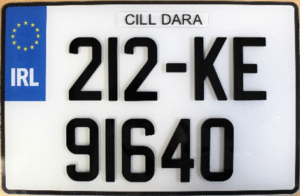Nowadays, it’s quite easy to purchase stylish 3D number plates for a vehicle to give it the personal touch, but did you know that the first automobiles didn’t even have any form of visible registration?
At the beginning of the 20th century – just as the popularity of motorised vehicles was increasing – many officials and ministers began to observe that accidents were happening more and more often, giving rise to the idea that a means of identifying cars – and their drivers – had become necessary.
By January 1904, The Motor Car Act in the UK had made it a legal requirement for all car owners to be registered, with their very own number plate to boot. The very first licence plate read – quite simply – A1. It was registered to Earl Russell, who was also the first person to want a distinctive number plate, given that he camped outside the issuing office in London all night to secure it.
Fast forward nearly 120 years and it seems nothing much has changed, as keen motorists still scramble to become the first to purchase personalised registrations before having 3D number plates printed up to attain the ultimate in automobile style.
Since 1904, the number plate system has changed no less than four times to accommodate the increased demand for vehicles in the country – and we’re going to look at these changes and how number plates have evolved over the years:
Original Dateless Plates (1903-1963)
Until 1963, there was nothing present on a number plate to signify the year it was issued. In fact, it appears very little thought went into the first number plates, as they were simply made up of a council identifying code (made up of three letters) followed by a random set of numbers (for example AAA111). By the time the early ‘50s rolled round, numbers had started to run out, meaning that the components were reversed – numbers first, followed by three-letter council designations.
Date Suffix (1963-1983)
The suffix system added a letter to the end of the original system to signify the year the car was registered – for example, a car registered in 1963 would read something like “AAA111A”. Cars in 1964 would read “AAA111B”, and so on.
Date Prefix (1983-2001)
As of August 1983, the letter indicating the year of registration was moved to the beginning – thereby doubling the lifespan of the number plate system. This was followed by a series of three numbers and three letters for ID purposes, and two letters at the end to indicate the area where the plate was registered.
Modern Registrations (2001-present)
When gathering evidence from hit-and-run incidents, police noticed that witnesses were more likely to recall the letters of a registration than the numbers. Because the brain finds it easier reading from left-to-right, it made sense to place alphabetical information at the beginning of the registration. Current plates feature a two-letter region signifier, followed by a date ID which changes every 6 months, followed by three random letters. The current system is more future-proof – and arguably looks much better when printed on 3D number plates!
Interesting Fact on Age Identifier Plates
The original A123 BCD type plates were brought in on 1st January, however everyone wanted their vehicle to be registered on this date which created massive vehicle sales on the 1st January, followed by reduced sales for the rest of the year.
As the Government quickly realised this, they moved the age identifier for the ‘B’ registration to the 1st August, resulting in ‘A’ plates only being produced for a shortened period. This meant they became quite rare.
From 1999, instead of A123 BCD plates having just the one registration per year, they moved to two. This was for two reasons:
- The two-registration system per year meant that there was a reduced pressure in high volume regions on the region identifier section, where they were on the point of running out of region identifiers.
- It was also a not too subtle way of trying to increase total annual sales of vehicle by creating a ‘need’ in buyer’s minds to have the very latest registered mark.
At Dash Dynamics, we provide letter manufacturing for our licensed and registered trade customers. For further information on how 3D number plates could enhance the look of your vehicle, why not take a look at the plate printing services we offer at Dash Dynamics and get in touch with a member of our team today.
